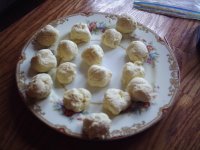
A reader recently e-mailed me and asked if I knew how to make
sirki (сырки). Sirki
(literally "little cheeses") are small, cheesecake-like bars made with
tvorog (farmer's cheese; similar to Quark cheese in Europe). I had never made sirki at home or tried storebought ones, so I did a little research: I asked my mom. She confirmed that sirki are made with tvorog and adds-ins like sour cream, vanilla, chocolate, nuts, raisins, etc.
Sirki were a favorite children's treat in Russia, and very small kids were sometimes plied with chocolate-covered sirki when they wanted ice cream. (I had never even tried sirki because, in the usual Soviet fashion, they disappeared from the stores around the time I was born.)
[Update: I finally tried them when I went to Estonia and Russia in 2008.]I found a few recipes for sirki-like desserts in Soviet cookbooks. The most common dessert is
tvorozhnya massa ( "tvorog mold"), made by creaming butter and sugar, then adding eggs, tvorog and sour cream, and chilling the whole thing on a rounded plate. All this sirki talk was making me (and my mom) hungry for the real thing, so we bought some sirki from the
Russian store in chocolate, almond and vanilla flavors. They tasted a lot like American-style cheesecake but were a bit tangy, like yogurt. Vanilla was the best of the bunch, but these sirki were cloyingly sweet and pricey.
Next I tried a recipe for chocolate-covered sirki from Anya von Bremzen's Russian cookbook
Please to the Table. "These rich chocolate-covered cheese confections, sold in the dairy department in Soviet grocery shops, used to be a favorite childhood treat," writes Anya.
The recipe has you mix
tvorog (I used 1.5 cups), 4
ounces
cream cheese,
sugar (Anya calls for 7 tbs; I used 3) and two
egg yolks in a food processor. I also added 1 tsp. of
vanilla extract. Then you add lemon zest, lemon extract and lemon juice, but I just used 3 tbs. of
lemon juice. (The tvorog/cream cheese mixture has a lot of culinary promise. It had a nice, smooth texture and tastes like mousse.)
Wrap the mixture in a damp cheesecloth and place in a sieve that's set over a bowl. Cover the cheesecloth with

a plate, put a weight on it (like a heavy can) and refrigerate overnight. The next day, use a small scooping spoon to shape the mixture into 1.5-inch balls.
Freeze the tvorog balls for half an hour to firm them up, then melt 12 ounces of decent
dark chocolate in a saucepan or double boiler and let it cool a little. Anya calls for melting the chocolate with 3 tbs. of
vegetable shortening; I used 1 tbs. and a splash of
heavy cream. I think shortening smells and tastes like stale oil, even when it's fresh, so I'd avoid it completely and simply use heavy cream to make a ganache.
Dip the tvorog balls in the chocolate and let cool on a wax-paper covered plate. Chill in the fridge until the chocolate is firm. I ended up with 15 or 16 sirki. They tasted like little cheesecakes and would work well as dessert or post-dessert bites. I think you can experiment a lot with this recipe, using ricotta instead of tvorog, or sour cream instead of cream cheese, and nuts, chocolate or dried fruit in the tvorog mixture.




















